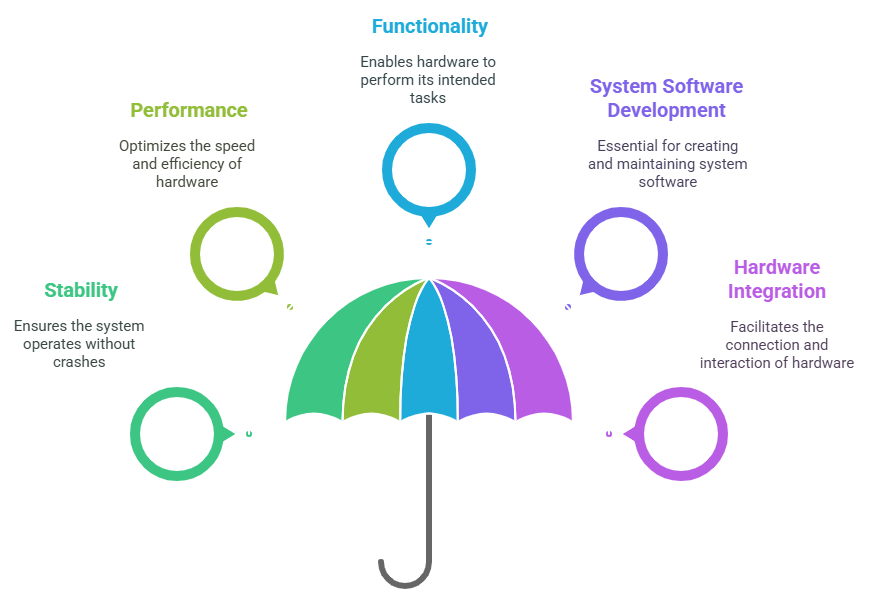
- Definition and Importance
- Types of System Software
- Operating Systems
- Device Drivers
- Utility Software
- System Software vs Application Software
- BIOS and Bootloaders
- Role in System Performance
Definition and Importance
System software is a vital category of computer programs designed to manage and control a computer’s hardware and provide a foundation for running application software. Acting as an intermediary between the user and the hardware, system software performs essential tasks such as memory management, process scheduling, device control, file system operations, and enforcing security protocols. Unlike application software, which performs specific user-oriented tasks, system software operates in the background and ensures that all components of the computer system function harmoniously and efficiently. It includes critical programs such as operating systems (like Windows, macOS, and Linux), device drivers, system utilities, and firmware, foundational knowledge often introduced in Web Designing Training. The importance of system software lies in its ability to manage hardware resources reliably and consistently. It ensures that the central processing unit (CPU), random-access memory (RAM), storage devices, and input/output devices operate smoothly and are accessible to various applications when needed. It also provides essential services like multitasking, user authentication, and error detection, which contribute to the system’s stability and security. Moreover, it facilitates user interaction through interfaces either command-line or graphical making the computer accessible and functional for users of all levels. Without system software, a computer would not be able to function. It serves as the backbone of the entire computing environment, ensuring that both hardware and software components can communicate and operate effectively. As such, system software is indispensable for the overall performance, usability, and reliability of modern computing systems, forming the core layer upon which all other software operates.
Would You Like to Know More About Web Developer? Sign Up For Our Web Developer Courses Now!
Types of System Software
System software encompasses various types of programs that are essential for operating and managing computer hardware and providing a platform for application software. These types work together to ensure that the entire computing system functions efficiently and securely. One of the most important types is the operating system (OS), such as Windows, Linux, or macOS. The OS manages hardware resources, runs applications, facilitates user interaction, and handles system-level tasks like file management, memory allocation, and process scheduling. Another key type is device drivers, which act as translators between the operating system and hardware components like printers, graphics cards, and network adapters, knowledge relevant for those exploring Front End Developer Salary in India. Without these drivers, the OS would not be able to communicate with hardware devices properly. Firmware is another type of system software embedded directly into hardware components. It provides low-level control for devices and is essential for starting and managing hardware before the operating system loads. Utility programs are also considered system software. These tools perform maintenance tasks such as disk cleanup, antivirus scanning, data backup, and system diagnostics. They help improve system performance and reliability by keeping the system in good working order.

Lastly, language translators like compilers, interpreters, and assemblers are system software that convert high-level programming code into machine language that the computer can understand and execute. Each type of system software plays a specific role in maintaining the functionality, stability, and performance of a computer system. Together, they form the foundation upon which all application software and user activities rely.
Operating Systems
- Definition and Role: An operating system (OS) is core system software that manages computer hardware and software resources. It acts as an intermediary between users and the physical components of a computer, enabling smooth operation of applications.
- Resource Management: The OS allocates and manages hardware resources such as the CPU, memory, storage devices, and input/output peripherals. This ensures that each running program receives adequate resources without conflicts.
- Process Management: Operating systems handle process scheduling and multitasking, allowing multiple programs to run simultaneously, concepts essential to understanding Control Statements in Java.
- Memory Management: The OS controls system memory, allocating RAM to active processes while ensuring efficient use of available memory. It handles virtual memory, paging, and swapping to extend usable memory beyond physical limits.
- File System Management: Operating systems provide a structured way to store, retrieve, and organize data on storage devices through file systems. They manage directories, file permissions, and data integrity.
- Security and Access Control: The OS enforces security policies to protect the system and user data. It controls user authentication, access permissions, and protects against unauthorized access and malware.
- User Interface: Operating systems provide a user interface, either command-line or graphical (GUI), allowing users to interact easily with the computer and its applications. This improves usability and accessibility.
- Definition and Purpose: Device drivers are specialized system software components that enable communication between the operating system and hardware devices. They translate OS commands into device-specific instructions, allowing hardware to function correctly.
- Hardware Abstraction: Drivers provide an abstraction layer that hides the complexity of hardware operations from the operating system and applications. This allows software to interact with different devices without needing to understand their internal workings.
- Types of Device Drivers: Common types include drivers for printers, graphics cards, network adapters, keyboards, and storage devices. Each driver is tailored to control a specific hardware component or device type, concepts sometimes covered in Web Designing Training.
- Operating System Integration: Device drivers are tightly integrated with the OS kernel, often loaded during system startup. The OS relies on them to detect, configure, and manage hardware components dynamically.
- Functionality and Control: Drivers manage hardware initialization, data transfer, and error handling. They ensure efficient communication, translating generic system calls into device-specific actions and returning device status or data.
- Updating and Compatibility: Drivers need regular updates to support new hardware features, fix bugs, or improve performance. Compatibility between drivers, hardware, and OS versions is critical for system stability and security.
- User Impact and Troubleshooting: Faulty or outdated drivers can cause hardware malfunctions, system crashes, or reduced performance. Proper driver management and troubleshooting are essential for maintaining a healthy computer system.
- Definition: System software is the core software that manages computer hardware and provides a platform for running application software. Application software consists of programs designed to perform specific user-oriented tasks such as word processing or web browsing.
- Purpose: The primary purpose of system software is to control and coordinate hardware components, ensuring efficient resource management and providing essential services to applications. Application software, on the other hand, directly helps users perform tasks and solve problems.
- Examples: Examples of system software include operating systems (Windows, macOS, Linux), device drivers, and utility programs. Application software examples are Microsoft Office, web browsers like Chrome, media players, and games.
- User Interaction: Users typically interact directly with application software to complete tasks. System software usually operates in the background and interacts with hardware and applications rather than the end user, similar to concepts covered in Exploring the Various Decorators in Angular.
- Dependency: Application software depends on system software to function. Without an operating system and supporting system software, application programs cannot run or access hardware resources.
- Functionality: System software performs low-level tasks such as memory management, process scheduling, and file handling. Application software performs higher-level tasks tailored to specific user needs like editing documents or managing databases.
- Installation and Updates: System software is often pre-installed with the computer and updated to enhance security and performance. Application software can be installed and uninstalled by users based on their requirements.
Are You Interested in Learning More About Web Developer? Sign Up For Our Web Developer Courses Today!
Device Drivers

Utility Software
Utility software is a type of system software designed to help manage, maintain, and optimize a computer system’s performance. Unlike application software, which allows users to perform specific tasks like word processing or web browsing, utility software focuses on system support functions that ensure the smooth operation of both hardware and software. These tools assist in executing routine tasks such as file management, data backup, antivirus scanning, disk cleanup, and system monitoring. One of the key roles of utility software is system optimization. Programs like disk defragmenters and performance monitors analyze and reorganize files on a hard drive to improve access speed and overall system efficiency. Security utilities, such as antivirus and anti-malware programs, protect the system from malicious threats, ensuring data integrity and user safety, important aspects when working with the Top 10 Python Libraries for Machine Learning. Backup utilities automate the process of saving copies of files or entire system states, which can be crucial in the event of data loss or system failure. Another common function is file management, where utilities help users to copy, move, delete, or organize files and folders. Compression tools, like WinRAR or 7-Zip, reduce file sizes for easier storage and faster transmission. Additionally, utilities like system information tools provide detailed reports about hardware and software components, aiding in troubleshooting and maintenance. In essence, utility software enhances the overall user experience by maintaining system health, improving performance, and protecting against data loss or cyber threats. It plays a crucial role in ensuring that computers operate efficiently, securely, and reliably in both personal and professional environments.
Do You Want to Learn More About Web Developer? Get Info From Our Web Developer Courses Today!
System Software vs Application Software
BIOS and Bootloaders
BIOS (Basic Input/Output System) and bootloaders are critical components in the startup process of a computer, working together to initialize hardware and load the operating system. The BIOS is firmware embedded on a computer’s motherboard, acting as the first code that runs when the system is powered on. Its primary function is to perform a Power-On Self-Test (POST), which checks the essential hardware components such as the CPU, memory, and storage devices to ensure they are functioning correctly. Once the hardware checks are complete, the BIOS identifies a bootable device (like a hard drive, SSD, or USB) and hands over control to the bootloader. The bootloader is a small program responsible for loading the operating system into memory and starting it, an example of Practical Applications of Python in system automation. It resides in a specific location on the bootable device, often the Master Boot Record (MBR) or GUID Partition Table (GPT) of a disk. Popular bootloaders include GRUB (used in many Linux systems) and Windows Boot Manager. The bootloader may present a menu allowing users to choose between multiple operating systems or kernel versions, especially in multi-boot setups. Together, BIOS and bootloaders enable the smooth transition from powered-off hardware to a fully operational operating system. While BIOS focuses on hardware initialization and device identification, the bootloader handles the loading and execution of the OS kernel. Modern computers increasingly use UEFI (Unified Extensible Firmware Interface), which replaces traditional BIOS with more advanced features, but the fundamental roles of firmware initialization and bootloading remain essential. Without BIOS and bootloaders, a computer would be unable to start or run any software, making them foundational elements of the computing process.
Role in System Performance
The role of system software in system performance is crucial, as it directly affects how efficiently a computer’s hardware and software resources are utilized. System software, including the operating system, device drivers, and utility programs, acts as the bridge between hardware components and application software, ensuring that tasks are executed smoothly and resources are allocated effectively. A well designed operating system manages CPU scheduling, memory allocation, and input/output operations, which optimizes the overall speed and responsiveness of the system. For instance, the operating system’s process scheduler determines which programs receive CPU time and for how long, balancing multiple tasks to prevent system slowdowns or crashes. Memory management, another key function, ensures that each application has sufficient memory without interfering with others, reducing bottlenecks and avoiding system crashes due to memory exhaustion, topics covered in Web Designing Training. Device drivers enable hardware peripherals like printers, graphics cards, and storage devices to communicate properly with the system, preventing compatibility issues that can degrade performance. Utility software also plays a vital role by performing maintenance tasks such as disk cleanup, defragmentation, and virus scanning. These activities remove unnecessary files, organize data storage, and protect against malware, all of which contribute to faster data access and improved system stability. Furthermore, system software enforces security protocols and monitors system health, helping to prevent unauthorized access and hardware failures that could otherwise cause significant performance drops. In summary, system software is foundational to maintaining and enhancing system performance. By efficiently managing resources, facilitating hardware communication, and supporting maintenance activities, system software ensures that computers run reliably, quickly, and securely, delivering a seamless user experience.





